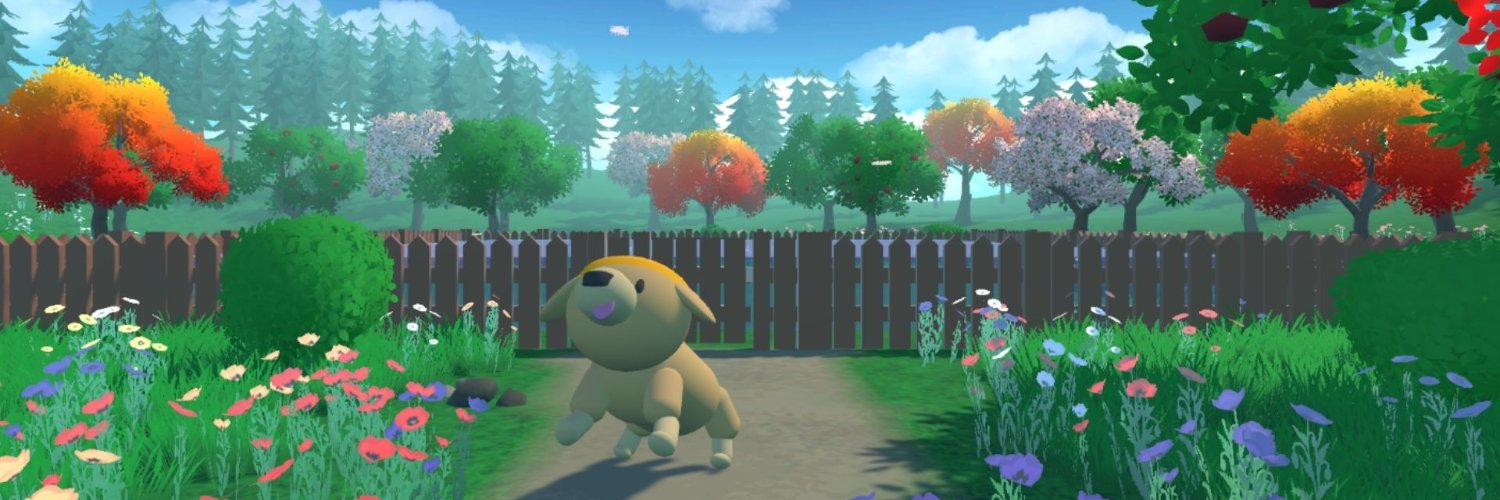Deep RL Course documentation
Train your first Deep Reinforcement Learning Agent 🤖
Train your first Deep Reinforcement Learning Agent 🤖
Now that you’ve studied the bases of Reinforcement Learning, you’re ready to train your first agent and share it with the community through the Hub 🔥: A Lunar Lander agent that will learn to land correctly on the Moon 🌕
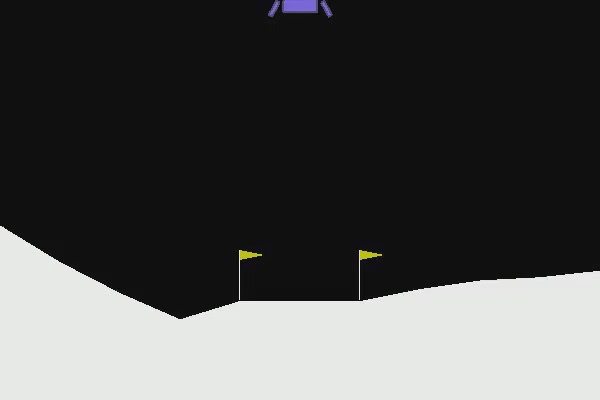
And finally, you’ll upload this trained agent to the Hugging Face Hub 🤗, a free, open platform where people can share ML models, datasets, and demos.
Thanks to our leaderboard, you’ll be able to compare your results with other classmates and exchange the best practices to improve your agent’s scores. Who will win the challenge for Unit 1 🏆?
To validate this hands-on for the certification process, you need to push your trained model to the Hub and get a result of >= 200.
To find your result, go to the leaderboard and find your model, the result = mean_reward - std of reward
If you don’t find your model, go to the bottom of the page and click on the refresh button.
For more information about the certification process, check this section 👉 https://huggingface.co/deep-rl-course/en/unit0/introduction#certification-process
And you can check your progress here 👉 https://huggingface.co/spaces/ThomasSimonini/Check-my-progress-Deep-RL-Course
So let’s get started! 🚀
To start the hands-on click on Open In Colab button 👇 :
We strongly recommend students use Google Colab for the hands-on exercises instead of running them on their personal computers.
By using Google Colab, you can focus on learning and experimenting without worrying about the technical aspects of setting up your environments.
Unit 1: Train your first Deep Reinforcement Learning Agent 🤖

In this notebook, you’ll train your first Deep Reinforcement Learning agent a Lunar Lander agent that will learn to land correctly on the Moon 🌕. Using Stable-Baselines3 a Deep Reinforcement Learning library, share them with the community, and experiment with different configurations
The environment 🎮
The library used 📚
We’re constantly trying to improve our tutorials, so if you find some issues in this notebook, please open an issue on the Github Repo.
Objectives of this notebook 🏆
At the end of the notebook, you will:
- Be able to use Gymnasium, the environment library.
- Be able to use Stable-Baselines3, the deep reinforcement learning library.
- Be able to push your trained agent to the Hub with a nice video replay and an evaluation score 🔥.
This notebook is from Deep Reinforcement Learning Course
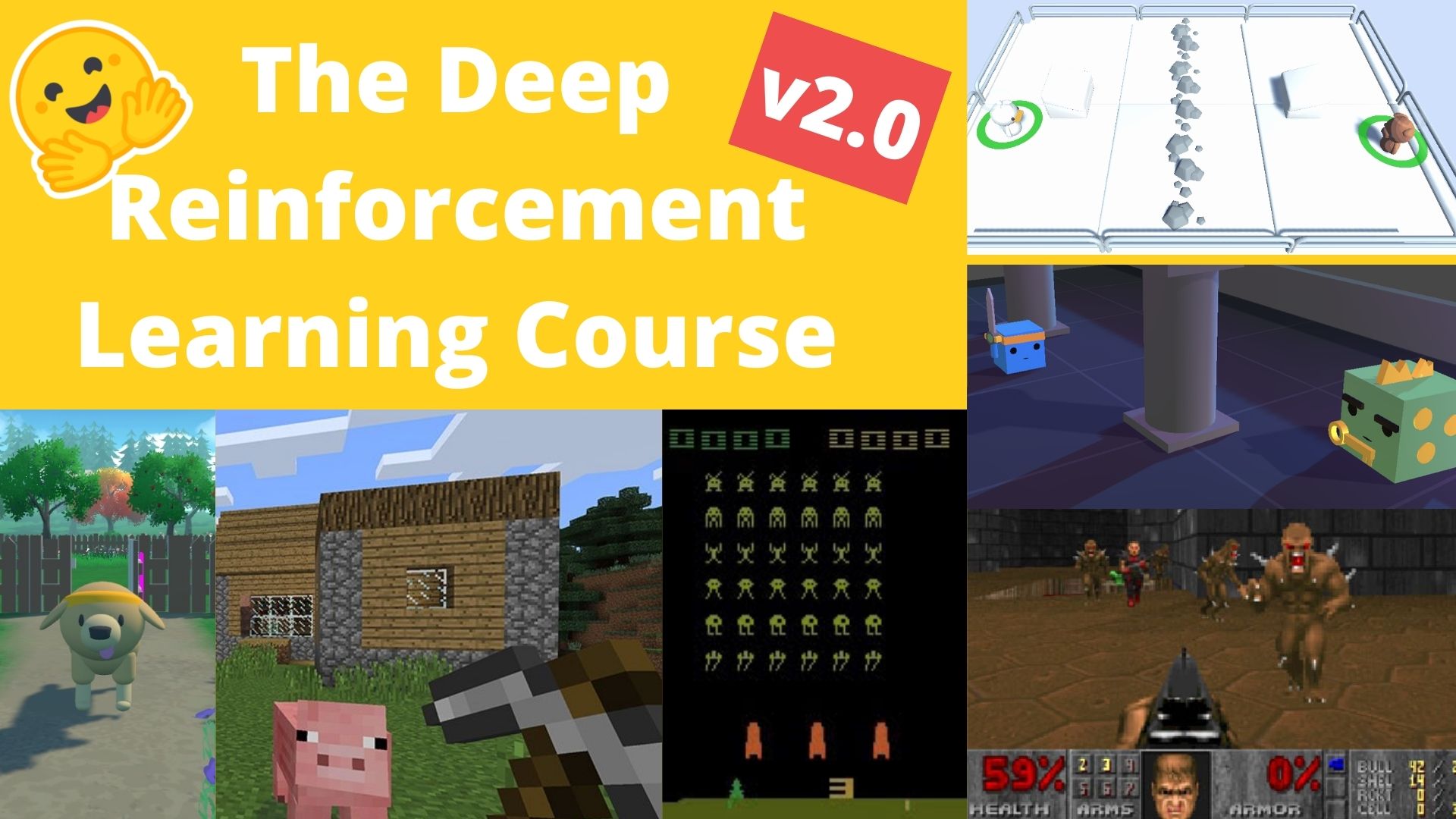
In this free course, you will:
- 📖 Study Deep Reinforcement Learning in theory and practice.
- 🧑💻 Learn to use famous Deep RL libraries such as Stable Baselines3, RL Baselines3 Zoo, CleanRL and Sample Factory 2.0.
- 🤖 Train agents in unique environments
- 🎓 Earn a certificate of completion by completing 80% of the assignments.
And more!
Check 📚 the syllabus 👉 https://simoninithomas.github.io/deep-rl-course
Don’t forget to sign up to the course (we are collecting your email to be able to send you the links when each Unit is published and give you information about the challenges and updates).
The best way to keep in touch and ask questions is to join our discord server to exchange with the community and with us 👉🏻 https://discord.gg/ydHrjt3WP5
Prerequisites 🏗️
Before diving into the notebook, you need to:
🔲 📝 Read Unit 0 that gives you all the information about the course and helps you to onboard 🤗
🔲 📚 Develop an understanding of the foundations of Reinforcement learning (MC, TD, Rewards hypothesis…) by reading Unit 1.
A small recap of Deep Reinforcement Learning 📚
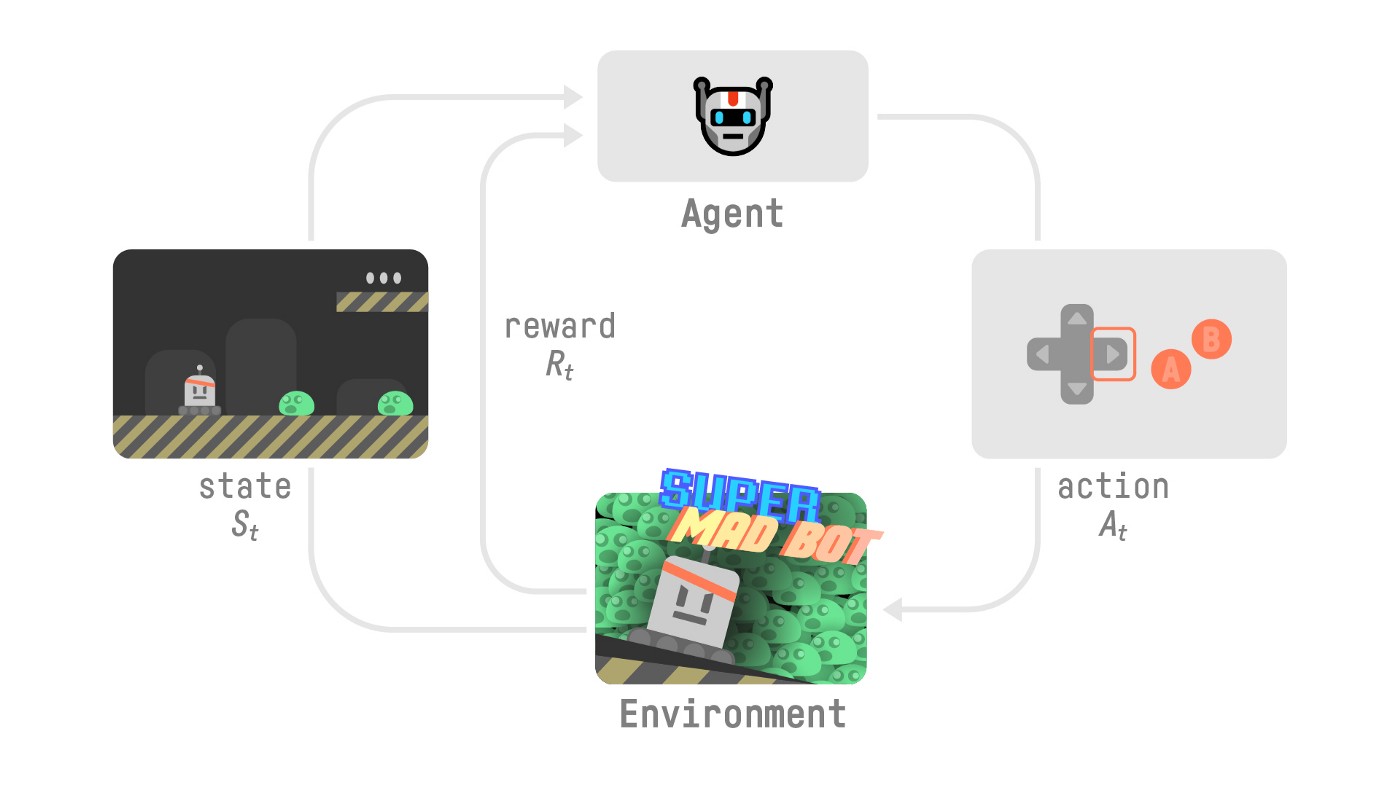
Let’s do a small recap on what we learned in the first Unit:
Reinforcement Learning is a computational approach to learning from actions. We build an agent that learns from the environment by interacting with it through trial and error and receiving rewards (negative or positive) as feedback.
The goal of any RL agent is to maximize its expected cumulative reward (also called expected return) because RL is based on the reward hypothesis, which is that all goals can be described as the maximization of an expected cumulative reward.
The RL process is a loop that outputs a sequence of state, action, reward, and next state.
To calculate the expected cumulative reward (expected return), we discount the rewards: the rewards that come sooner (at the beginning of the game) are more probable to happen since they are more predictable than the long-term future reward.
To solve an RL problem, you want to find an optimal policy; the policy is the “brain” of your AI that will tell us what action to take given a state. The optimal one is the one that gives you the actions that max the expected return.
There are two ways to find your optimal policy:
By training your policy directly: policy-based methods.
By training a value function that tells us the expected return the agent will get at each state and use this function to define our policy: value-based methods.
Finally, we spoke about Deep RL because we introduce deep neural networks to estimate the action to take (policy-based) or to estimate the value of a state (value-based) hence the name “deep.”
Let’s train our first Deep Reinforcement Learning agent and upload it to the Hub 🚀
Get a certificate 🎓
To validate this hands-on for the certification process, you need to push your trained model to the Hub and get a result of >= 200.
To find your result, go to the leaderboard and find your model, the result = mean_reward - std of reward
For more information about the certification process, check this section 👉 https://huggingface.co/deep-rl-course/en/unit0/introduction#certification-process
Set the GPU 💪
- To accelerate the agent’s training, we’ll use a GPU. To do that, go to
Runtime > Change Runtime type
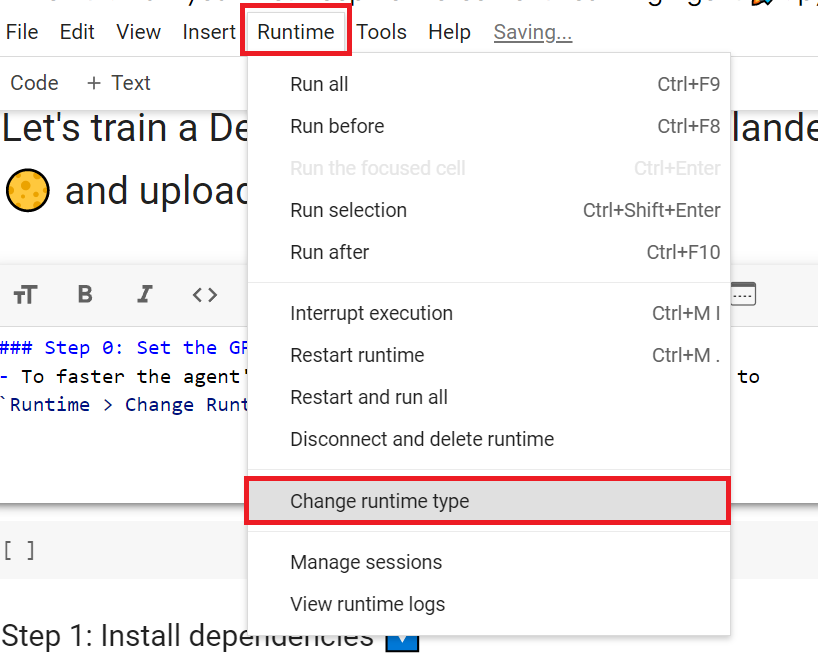
Hardware Accelerator > GPU
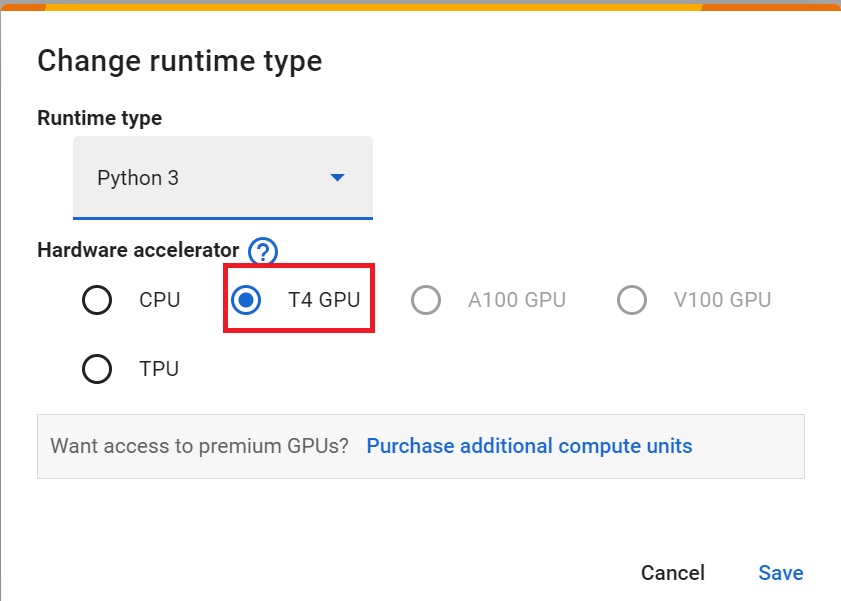
Install dependencies and create a virtual screen 🔽
The first step is to install the dependencies, we’ll install multiple ones.
gymnasium[box2d]: Contains the LunarLander-v2 environment 🌛stable-baselines3[extra]: The deep reinforcement learning library.huggingface_sb3: Additional code for Stable-baselines3 to load and upload models from the Hugging Face 🤗 Hub.
To make things easier, we created a script to install all these dependencies.
apt install swig cmake
pip install -r https://raw.githubusercontent.com/huggingface/deep-rl-class/main/notebooks/unit1/requirements-unit1.txt
During the notebook, we’ll need to generate a replay video. To do so, with colab, we need to have a virtual screen to be able to render the environment (and thus record the frames).
Hence the following cell will install virtual screen libraries and create and run a virtual screen 🖥
sudo apt-get update apt install python3-opengl apt install ffmpeg apt install xvfb pip3 install pyvirtualdisplay
To make sure the new installed libraries are used, sometimes it’s required to restart the notebook runtime. The next cell will force the runtime to crash, so you’ll need to connect again and run the code starting from here. Thanks to this trick, we will be able to run our virtual screen.
import os
os.kill(os.getpid(), 9)# Virtual display
from pyvirtualdisplay import Display
virtual_display = Display(visible=0, size=(1400, 900))
virtual_display.start()Import the packages 📦
One additional library we import is huggingface_hub to be able to upload and download trained models from the hub.
The Hugging Face Hub 🤗 works as a central place where anyone can share and explore models and datasets. It has versioning, metrics, visualizations and other features that will allow you to easily collaborate with others.
You can see here all the Deep reinforcement Learning models available here👉 https://huggingface.co/models?pipeline_tag=reinforcement-learning&sort=downloads
import gymnasium
from huggingface_sb3 import load_from_hub, package_to_hub
from huggingface_hub import (
notebook_login,
) # To log to our Hugging Face account to be able to upload models to the Hub.
from stable_baselines3 import PPO
from stable_baselines3.common.env_util import make_vec_env
from stable_baselines3.common.evaluation import evaluate_policy
from stable_baselines3.common.monitor import MonitorUnderstand Gymnasium and how it works 🤖
🏋 The library containing our environment is called Gymnasium. You’ll use Gymnasium a lot in Deep Reinforcement Learning.
Gymnasium is the new version of Gym library maintained by the Farama Foundation.
The Gymnasium library provides two things:
- An interface that allows you to create RL environments.
- A collection of environments (gym-control, atari, box2D…).
Let’s look at an example, but first let’s recall the RL loop.

At each step:
- Our Agent receives a state (S0) from the Environment — we receive the first frame of our game (Environment).
- Based on that state (S0), the Agent takes an action (A0) — our Agent will move to the right.
- The environment transitions to a new state (S1) — new frame.
- The environment gives some reward (R1) to the Agent — we’re not dead (Positive Reward +1).
With Gymnasium:
1️⃣ We create our environment using gymnasium.make()
2️⃣ We reset the environment to its initial state with observation = env.reset()
At each step:
3️⃣ Get an action using our model (in our example we take a random action)
4️⃣ Using env.step(action), we perform this action in the environment and get
observation: The new state (st+1)reward: The reward we get after executing the actionterminated: Indicates if the episode terminated (agent reach the terminal state)truncated: Introduced with this new version, it indicates a timelimit or if an agent go out of bounds of the environment for instance.info: A dictionary that provides additional information (depends on the environment).
For more explanations check this 👉 https://gymnasium.farama.org/api/env/#gymnasium.Env.step
If the episode is terminated:
- We reset the environment to its initial state with
observation = env.reset()
Let’s look at an example! Make sure to read the code
import gymnasium as gym
# First, we create our environment called LunarLander-v2
env = gym.make("LunarLander-v2")
# Then we reset this environment
observation, info = env.reset()
for _ in range(20):
# Take a random action
action = env.action_space.sample()
print("Action taken:", action)
# Do this action in the environment and get
# next_state, reward, terminated, truncated and info
observation, reward, terminated, truncated, info = env.step(action)
# If the game is terminated (in our case we land, crashed) or truncated (timeout)
if terminated or truncated:
# Reset the environment
print("Environment is reset")
observation, info = env.reset()
env.close()Create the LunarLander environment 🌛 and understand how it works
The environment 🎮
In this first tutorial, we’re going to train our agent, a Lunar Lander, to land correctly on the moon. To do that, the agent needs to learn to adapt its speed and position (horizontal, vertical, and angular) to land correctly.
💡 A good habit when you start to use an environment is to check its documentation
👉 https://gymnasium.farama.org/environments/box2d/lunar_lander/
Let’s see what the Environment looks like:
# We create our environment with gym.make("<name_of_the_environment>")
env = gym.make("LunarLander-v2")
env.reset()
print("_____OBSERVATION SPACE_____ \n")
print("Observation Space Shape", env.observation_space.shape)
print("Sample observation", env.observation_space.sample()) # Get a random observationWe see with Observation Space Shape (8,) that the observation is a vector of size 8, where each value contains different information about the lander:
- Horizontal pad coordinate (x)
- Vertical pad coordinate (y)
- Horizontal speed (x)
- Vertical speed (y)
- Angle
- Angular speed
- If the left leg contact point has touched the land (boolean)
- If the right leg contact point has touched the land (boolean)
print("\n _____ACTION SPACE_____ \n")
print("Action Space Shape", env.action_space.n)
print("Action Space Sample", env.action_space.sample()) # Take a random actionThe action space (the set of possible actions the agent can take) is discrete with 4 actions available 🎮:
- Action 0: Do nothing,
- Action 1: Fire left orientation engine,
- Action 2: Fire the main engine,
- Action 3: Fire right orientation engine.
Reward function (the function that will give a reward at each timestep) 💰:
After every step a reward is granted. The total reward of an episode is the sum of the rewards for all the steps within that episode.
For each step, the reward:
- Is increased/decreased the closer/further the lander is to the landing pad.
- Is increased/decreased the slower/faster the lander is moving.
- Is decreased the more the lander is tilted (angle not horizontal).
- Is increased by 10 points for each leg that is in contact with the ground.
- Is decreased by 0.03 points each frame a side engine is firing.
- Is decreased by 0.3 points each frame the main engine is firing.
The episode receive an additional reward of -100 or +100 points for crashing or landing safely respectively.
An episode is considered a solution if it scores at least 200 points.
Vectorized Environment
- We create a vectorized environment (a method for stacking multiple independent environments into a single environment) of 16 environments, this way, we’ll have more diverse experiences during the training.
# Create the environment
env = make_vec_env("LunarLander-v2", n_envs=16)Create the Model 🤖
We have studied our environment and we understood the problem: being able to land the Lunar Lander to the Landing Pad correctly by controlling left, right and main orientation engine. Now let’s build the algorithm we’re going to use to solve this Problem 🚀.
To do so, we’re going to use our first Deep RL library, Stable Baselines3 (SB3).
SB3 is a set of reliable implementations of reinforcement learning algorithms in PyTorch.
💡 A good habit when using a new library is to dive first on the documentation: https://stable-baselines3.readthedocs.io/en/master/ and then try some tutorials.
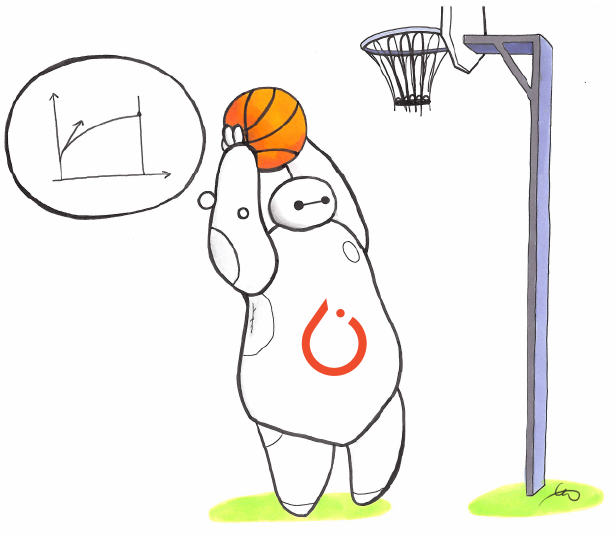
To solve this problem, we’re going to use SB3 PPO. PPO (aka Proximal Policy Optimization) is one of the SOTA (state of the art) Deep Reinforcement Learning algorithms that you’ll study during this course.
PPO is a combination of:
- Value-based reinforcement learning method: learning an action-value function that will tell us the most valuable action to take given a state and action.
- Policy-based reinforcement learning method: learning a policy that will give us a probability distribution over actions.
Stable-Baselines3 is easy to set up:
1️⃣ You create your environment (in our case it was done above)
2️⃣ You define the model you want to use and instantiate this model model = PPO("MlpPolicy")
3️⃣ You train the agent with model.learn and define the number of training timesteps
# Create environment
env = gym.make('LunarLander-v2')
# Instantiate the agent
model = PPO('MlpPolicy', env, verbose=1)
# Train the agent
model.learn(total_timesteps=int(2e5))# TODO: Define a PPO MlpPolicy architecture
# We use MultiLayerPerceptron (MLPPolicy) because the input is a vector,
# if we had frames as input we would use CnnPolicy
model =Solution
# SOLUTION
# We added some parameters to accelerate the training
model = PPO(
policy="MlpPolicy",
env=env,
n_steps=1024,
batch_size=64,
n_epochs=4,
gamma=0.999,
gae_lambda=0.98,
ent_coef=0.01,
verbose=1,
)Train the PPO agent 🏃
- Let’s train our agent for 1,000,000 timesteps, don’t forget to use GPU on Colab. It will take approximately ~20min, but you can use fewer timesteps if you just want to try it out.
- During the training, take a ☕ break you deserved it 🤗
# TODO: Train it for 1,000,000 timesteps
# TODO: Specify file name for model and save the model to file
model_name = "ppo-LunarLander-v2"Solution
# SOLUTION
# Train it for 1,000,000 timesteps
model.learn(total_timesteps=1000000)
# Save the model
model_name = "ppo-LunarLander-v2"
model.save(model_name)Evaluate the agent 📈
- Remember to wrap the environment in a Monitor.
- Now that our Lunar Lander agent is trained 🚀, we need to check its performance.
- Stable-Baselines3 provides a method to do that:
evaluate_policy. - To fill that part you need to check the documentation
- In the next step, we’ll see how to automatically evaluate and share your agent to compete in a leaderboard, but for now let’s do it ourselves
💡 When you evaluate your agent, you should not use your training environment but create an evaluation environment.
# TODO: Evaluate the agent
# Create a new environment for evaluation
eval_env =
# Evaluate the model with 10 evaluation episodes and deterministic=True
mean_reward, std_reward =
# Print the resultsSolution
# @title
eval_env = Monitor(gym.make("LunarLander-v2"))
mean_reward, std_reward = evaluate_policy(model, eval_env, n_eval_episodes=10, deterministic=True)
print(f"mean_reward={mean_reward:.2f} +/- {std_reward}")- In my case, I got a mean reward of
200.20 +/- 20.80after training for 1 million steps, which means that our lunar lander agent is ready to land on the moon 🌛🥳.
Publish our trained model on the Hub 🔥
Now that we saw we got good results after the training, we can publish our trained model on the hub 🤗 with one line of code.
📚 The libraries documentation 👉 https://github.com/huggingface/huggingface_sb3/tree/main#hugging-face—x-stable-baselines3-v20
Here’s an example of a Model Card (with Space Invaders):
By using package_to_hub you evaluate, record a replay, generate a model card of your agent and push it to the hub.
This way:
- You can showcase our work 🔥
- You can visualize your agent playing 👀
- You can share with the community an agent that others can use 💾
- You can access a leaderboard 🏆 to see how well your agent is performing compared to your classmates 👉 https://huggingface.co/spaces/huggingface-projects/Deep-Reinforcement-Learning-Leaderboard
To be able to share your model with the community there are three more steps to follow:
1️⃣ (If it’s not already done) create an account on Hugging Face ➡ https://huggingface.co/join
2️⃣ Sign in and then, you need to store your authentication token from the Hugging Face website.
- Create a new token (https://huggingface.co/settings/tokens) with write role
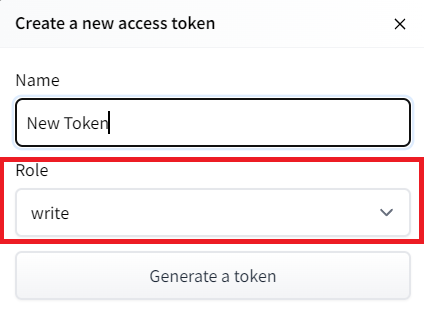
- Copy the token
- Run the cell below and paste the token
notebook_login()
!git config --global credential.helper storeIf you don’t want to use a Google Colab or a Jupyter Notebook, you need to use this command instead: huggingface-cli login
3️⃣ We’re now ready to push our trained agent to the 🤗 Hub 🔥 using package_to_hub() function
Let’s fill the package_to_hub function:
model: our trained model.model_name: the name of the trained model that we defined inmodel_savemodel_architecture: the model architecture we used, in our case PPOenv_id: the name of the environment, in our caseLunarLander-v2eval_env: the evaluation environment defined in eval_envrepo_id: the name of the Hugging Face Hub Repository that will be created/updated(repo_id = {username}/{repo_name})
💡 A good name is {username}/{model_architecture}-{env_id}
commit_message: message of the commit
import gymnasium as gym
from stable_baselines3.common.vec_env import DummyVecEnv
from stable_baselines3.common.env_util import make_vec_env
from huggingface_sb3 import package_to_hub
## TODO: Define a repo_id
## repo_id is the id of the model repository from the Hugging Face Hub (repo_id = {organization}/{repo_name} for instance ThomasSimonini/ppo-LunarLander-v2
repo_id =
# TODO: Define the name of the environment
env_id =
# Create the evaluation env and set the render_mode="rgb_array"
eval_env = DummyVecEnv([lambda: gym.make(env_id, render_mode="rgb_array")])
# TODO: Define the model architecture we used
model_architecture = ""
## TODO: Define the commit message
commit_message = ""
# method save, evaluate, generate a model card and record a replay video of your agent before pushing the repo to the hub
package_to_hub(model=model, # Our trained model
model_name=model_name, # The name of our trained model
model_architecture=model_architecture, # The model architecture we used: in our case PPO
env_id=env_id, # Name of the environment
eval_env=eval_env, # Evaluation Environment
repo_id=repo_id, # id of the model repository from the Hugging Face Hub (repo_id = {organization}/{repo_name} for instance ThomasSimonini/ppo-LunarLander-v2
commit_message=commit_message)Solution
import gymnasium as gym
from stable_baselines3 import PPO
from stable_baselines3.common.vec_env import DummyVecEnv
from stable_baselines3.common.env_util import make_vec_env
from huggingface_sb3 import package_to_hub
# PLACE the variables you've just defined two cells above
# Define the name of the environment
env_id = "LunarLander-v2"
# TODO: Define the model architecture we used
model_architecture = "PPO"
## Define a repo_id
## repo_id is the id of the model repository from the Hugging Face Hub (repo_id = {organization}/{repo_name} for instance ThomasSimonini/ppo-LunarLander-v2
## CHANGE WITH YOUR REPO ID
repo_id = "ThomasSimonini/ppo-LunarLander-v2" # Change with your repo id, you can't push with mine 😄
## Define the commit message
commit_message = "Upload PPO LunarLander-v2 trained agent"
# Create the evaluation env and set the render_mode="rgb_array"
eval_env = DummyVecEnv([lambda: Monitor(gym.make(env_id, render_mode="rgb_array"))])
# PLACE the package_to_hub function you've just filled here
package_to_hub(
model=model, # Our trained model
model_name=model_name, # The name of our trained model
model_architecture=model_architecture, # The model architecture we used: in our case PPO
env_id=env_id, # Name of the environment
eval_env=eval_env, # Evaluation Environment
repo_id=repo_id, # id of the model repository from the Hugging Face Hub (repo_id = {organization}/{repo_name} for instance ThomasSimonini/ppo-LunarLander-v2
commit_message=commit_message,
)Congrats 🥳 you’ve just trained and uploaded your first Deep Reinforcement Learning agent. The script above should have displayed a link to a model repository such as https://huggingface.co/osanseviero/test_sb3. When you go to this link, you can:
- See a video preview of your agent at the right.
- Click “Files and versions” to see all the files in the repository.
- Click “Use in stable-baselines3” to get a code snippet that shows how to load the model.
- A model card (
README.mdfile) which gives a description of the model
Under the hood, the Hub uses git-based repositories (don’t worry if you don’t know what git is), which means you can update the model with new versions as you experiment and improve your agent.
Compare the results of your LunarLander-v2 with your classmates using the leaderboard 🏆 👉 https://huggingface.co/spaces/huggingface-projects/Deep-Reinforcement-Learning-Leaderboard
Load a saved LunarLander model from the Hub 🤗
Thanks to ironbar for the contribution.
Loading a saved model from the Hub is really easy.
You go to https://huggingface.co/models?library=stable-baselines3 to see the list of all the Stable-baselines3 saved models.
- You select one and copy its repo_id
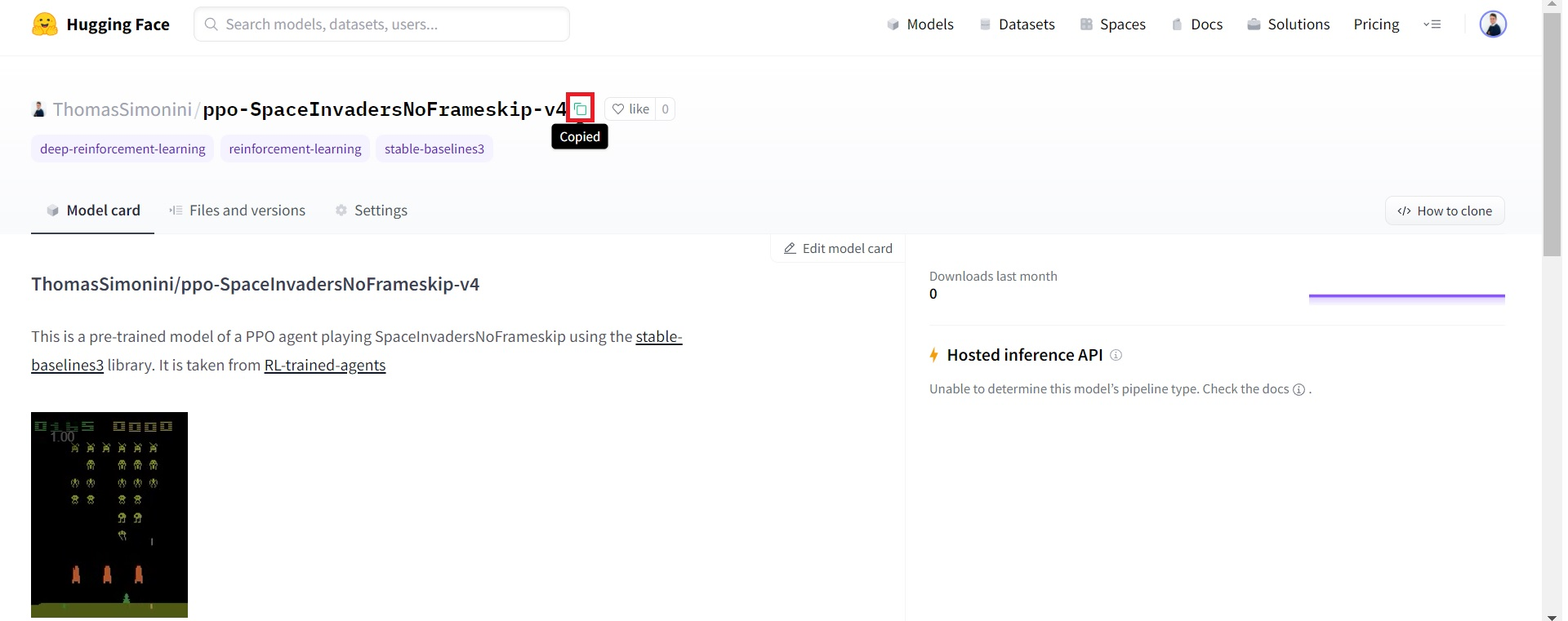
- Then we just need to use load_from_hub with:
- The repo_id
- The filename: the saved model inside the repo and its extension (*.zip)
Because the model I download from the Hub was trained with Gym (the former version of Gymnasium) we need to install shimmy a API conversion tool that will help us to run the environment correctly.
Shimmy Documentation: https://github.com/Farama-Foundation/Shimmy
!pip install shimmy
from huggingface_sb3 import load_from_hub
repo_id = "Classroom-workshop/assignment2-omar" # The repo_id
filename = "ppo-LunarLander-v2.zip" # The model filename.zip
# When the model was trained on Python 3.8 the pickle protocol is 5
# But Python 3.6, 3.7 use protocol 4
# In order to get compatibility we need to:
# 1. Install pickle5 (we done it at the beginning of the colab)
# 2. Create a custom empty object we pass as parameter to PPO.load()
custom_objects = {
"learning_rate": 0.0,
"lr_schedule": lambda _: 0.0,
"clip_range": lambda _: 0.0,
}
checkpoint = load_from_hub(repo_id, filename)
model = PPO.load(checkpoint, custom_objects=custom_objects, print_system_info=True)Let’s evaluate this agent:
# @title
eval_env = Monitor(gym.make("LunarLander-v2"))
mean_reward, std_reward = evaluate_policy(model, eval_env, n_eval_episodes=10, deterministic=True)
print(f"mean_reward={mean_reward:.2f} +/- {std_reward}")Some additional challenges 🏆
The best way to learn is to try things by your own! As you saw, the current agent is not doing great. As a first suggestion, you can train for more steps. With 1,000,000 steps, we saw some great results!
In the Leaderboard you will find your agents. Can you get to the top?
Here are some ideas to achieve so:
- Train more steps
- Try different hyperparameters for
PPO. You can see them at https://stable-baselines3.readthedocs.io/en/master/modules/ppo.html#parameters. - Check the Stable-Baselines3 documentation and try another model such as DQN.
- Push your new trained model on the Hub 🔥
Compare the results of your LunarLander-v2 with your classmates using the leaderboard 🏆
Is moon landing too boring for you? Try to change the environment, why not use MountainCar-v0, CartPole-v1 or CarRacing-v0? Check how they work using the gym documentation and have fun 🎉.
Congrats on finishing this chapter! That was the biggest one, and there was a lot of information.
If you’re still feel confused with all these elements…it’s totally normal! This was the same for me and for all people who studied RL.
Take time to really grasp the material before continuing and try the additional challenges. It’s important to master these elements and have a solid foundations.
Naturally, during the course, we’re going to dive deeper into these concepts but it’s better to have a good understanding of them now before diving into the next chapters.
Next time, in the bonus unit 1, you’ll train Huggy the Dog to fetch the stick.
